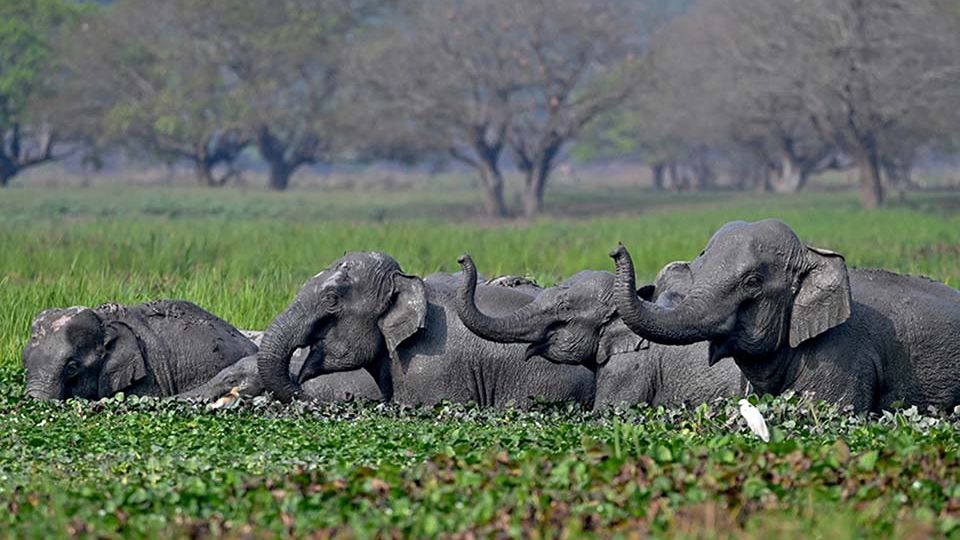October 30, 2025
NEW DELHI – The state of Asian elephant estimation 2025 conducted by the Wildlife Institute of India for the country reveals that the population has come down from 29,964 in 2017 to 22,446 in 2025. The methodology for the census has undergone a change and for the first time DNA-based mark capture-recapture and scientifically peer-reviewed methodology has been deployed. A similar methodology has been used for tiger estimation every four years from 2007. Prior to 2007, the tiger census was being done using the pug-mark method and the total number of tigers in the country was reported to be 20,000 plus.
When peer reviewed mark capture-recapture methodology (stripes of two individual tigers are different) was adopted, tiger numbers drastically came down to 1,411. Poaching did not account for such a steep decline; the earlier census method was flawed and states used to boost the figures to show higher tiger numbers, to indicate a better conservation strategy and to get themselves a pat on the back. Human deaths in conflict with elephants are far higher than deaths in tiger related conflicts. Though the Union Government launched Project Elephant in 1992, the elephant census was done by states duly coordinating with adjoining states. Project Elephant finally collated states’ data and published statewide/ landscape wise population figures.
Two methodologies adopted for the census were block count and dung count. The block count method often tends to overestimate the number, while the elephant dung count method comes up with a more accurate number. By walking along transects, an observer can find elephant defecation rate as well as dung decay rate. Generally it takes three months for elephants’ dung to decay; the period varies in different eco-climatic zones. Both methods are incomplete without a water hole count for elephants, needed to determine the composition of male, female, calf, adult, sub-adult, tuskers etc in the herd. Tigers and elephants often share common habitats.
The most recent methodology that the Wildlife Institute of India undertook was named Synchronous All India Elephant Estimation Program, 2021-25 (SAIEE-2021-25). The forested landscape was divided into 100 sq km cells, which were fur ther subdivided into 25 sq km and 4 sq km cells, the design adopted for All India tiger estimation since 2006. In a week-long field protocol in every cell, ground surveys in forested landscapes were carried out simultaneously in all tiger bearing states of India.
The observers moved on a 6.5 km long transect in a 25 sq km cell, generally along the diagonal and recorded carnivore and mega herbivore sign encounters, ungulate abundance, dung count of ungulates, vegetation status observed in small 100mx100m plots and human disturbances. The information helped in modeling elephant occupancy. The distribution and abundance of wildlife is a function of elephant characteristics and anthropogenic impacts. On the conclusion of sign survey exercise, each landscape was adequately sampled using area search methods and camera traps. Multiple covariates associated with elephant density such as distance to water, terrain ruggedness, proximity to night light sources, and human footprint matrices from ground surveys were used to work out elephant encounter rates.
DNA-based elephant population found in this estimation was compared with the last elephant census results of 2017. It was observed that elephants have dwindled in the Northeastern hills and Brahmaputra floodplains landscape from 10,139 to 6,559; in central Indian Highlands and Eastern Ghats from 3,128 to 1,891 and in the Western Ghats landscape from 14,587 to 11,934. Shivalik and Gangetic plains landscape showed that the population has remained stable, though there is a negligible loss from 2085 to 2062.
A state wise comparison reveals that while the population has remained stable in Karnataka, Tamil Nadu, West Bengal, Uttarakhand and Uttar Pradesh, it has suffered a considerable loss in states such as Assam, Odisha, Jharkhand, Kerala etc. It appears that the states using both traditional methods (Block Count and Dung Count) have been reporting more accurate numbers, while the states using only one block count method have suffered losses. The next question is whether we have really lost nearly 25 per cent of our elephants in eight years. There is no doubt that instances of habitat degradation and fragmentation, retaliatory fencing around farms, electrocution and killing by trains are on the increase.
Seventy per cent of unnatural deaths of elephants are linked to electrocution. MoEFCC data suggests that 500 elephants died from electrocution, 100 were hit by trains and 50 were poached for tusks. To save elephants and other wild animals from train collisions, 77 stretches across 14 states have been identified as high-risk for wild animals, but the implementation of mitigation measures like construction of elephant passes as well as tracking and coordinating with railways to slow down trains if animals are found on the track has considerable loopholes.
Further, but not in all cases, mitigation structures on stretches of national highways passing through elephant zones have been constructed. Expansion of rail and road infrastructures has been done at an alarming rate in the past decade and it has left elephant habitats and corridors fragmented and degraded. Deforestation in elephant habitats is also triggered by flawed implementation of the Forest Rights Ac t , 2006. States with p o or implementation of the Act have lost elephants in the past eight years.
We probably cannot take shelter under change in methodology of census; we must pull up our socks to see that wherever possible corridors and habitats are restored, rights are granted in the forests on satellite imagery-based evidence and cases of conflict, especially human death, are dealt with by Forest departments in a more humane way. Enforcement of forest laws, too, must be stepped up.
The writer is retired head of Forest Force, Karnataka.


